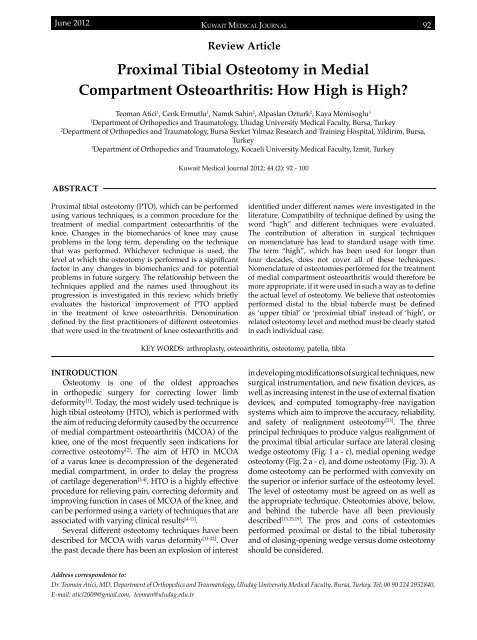Vol 44 # 2 June 2012 - Kma.org.kw
Vol 44 # 2 June 2012 - Kma.org.kw
Vol 44 # 2 June 2012 - Kma.org.kw
Create successful ePaper yourself
Turn your PDF publications into a flip-book with our unique Google optimized e-Paper software.
<strong>June</strong> <strong>2012</strong><br />
KUWAIT MEDICAL JOURNAL 92<br />
Review Article<br />
Proximal Tibial Osteotomy in Medial<br />
Compartment Osteoarthritis: How High is High?<br />
Teoman Atici 1 , Cenk Ermutlu 1 , Namık Sahin 2 , Alpaslan Ozturk 2 , Kaya Memisoglu 3<br />
1<br />
Department of Orthopedics and Traumatology, Uludag University Medical Faculty, Bursa, Turkey<br />
2<br />
Department of Orthopedics and Traumatology, Bursa Sevket Yılmaz Research and Training Hospital, Yildirim, Bursa,<br />
Turkey<br />
3<br />
Department of Orthopedics and Traumatology, Kocaeli University Medical Faculty, Izmit, Turkey<br />
Kuwait Medical Journal <strong>2012</strong>; <strong>44</strong> (2): 92 - 100<br />
ABSTRACT<br />
Proximal tibial osteotomy (PTO), which can be performed<br />
using various techniques, is a common procedure for the<br />
treatment of medial compartment osteoarthritis of the<br />
knee. Changes in the biomechanics of knee may cause<br />
problems in the long term, depending on the technique<br />
that was performed. Whichever technique is used, the<br />
level at which the osteotomy is performed is a significant<br />
factor in any changes in biomechanics and for potential<br />
problems in future surgery. The relationship between the<br />
techniques applied and the names used throughout its<br />
progression is investigated in this review, which briefly<br />
evaluates the historical improvement of PTO applied<br />
in the treatment of knee osteoarthritis. Denomination<br />
defined by the first practitioners of different osteotomies<br />
that were used in the treatment of knee osteoarthritis and<br />
identified under different names were investigated in the<br />
literature. Compatibilty of technique defined by using the<br />
word “high” and different techniques were evaluated.<br />
The contribution of alteration in surgical techniques<br />
on nomenclature has lead to standard usage with time.<br />
The term “high”, which has been used for longer than<br />
four decades, does not cover all of these techniques.<br />
Nomenclature of osteotomies performed for the treatment<br />
of medial compartment osteoarthritis would therefore be<br />
more appropriate, if it were used in such a way as to define<br />
the actual level of osteotomy. We believe that osteotomies<br />
performed distal to the tibial tubercle must be defined<br />
as ‘upper tibial’ or ‘proximial tibial’ instead of ‘high’, or<br />
related osteotomy level and method must be clearly stated<br />
in each individual case.<br />
KEY WORDS: arthroplasty, osteoarthritis, osteotomy, patella, tibia<br />
INTRODUCTION<br />
Osteotomy is one of the oldest approaches<br />
in orthopedic surgery for correcting lower limb<br />
deformity [1] . Today, the most widely used technique is<br />
high tibial osteotomy (HTO), which is performed with<br />
the aim of reducing deformity caused by the occurrence<br />
of medial compartment osteoarthritis (MCOA) of the<br />
knee, one of the most frequently seen indications for<br />
corrective osteotomy [2] . The aim of HTO in MCOA<br />
of a varus knee is decompression of the degenerated<br />
medial compartment, in order to delay the progress<br />
of cartilage degeneration [3,4] . HTO is a highly effective<br />
procedure for relieving pain, correcting deformity and<br />
improving function in cases of MCOA of the knee, and<br />
can be performed using a variety of techniques that are<br />
associated with varying clinical results [4-11] .<br />
Several different osteotomy techniques have been<br />
described for MCOA with varus deformity [11-22] . Over<br />
the past decade there has been an explosion of interest<br />
in developing modifications of surgical techniques, new<br />
surgical instrumentation, and new fixation devices, as<br />
well as increasing interest in the use of external fixation<br />
devices, and computed tomography-free navigation<br />
systems which aim to improve the accuracy, reliability,<br />
and safety of realignment osteotomy [23] . The three<br />
principal techniques to produce valgus realignment of<br />
the proximal tibial articular surface are lateral closing<br />
wedge osteotomy (Fig. 1 a - c), medial opening wedge<br />
osteotomy (Fig. 2 a - c), and dome osteotomy (Fig. 3). A<br />
dome osteotomy can be performed with convexity on<br />
the superior or inferior surface of the osteotomy level.<br />
The level of osteotomy must be agreed on as well as<br />
the appropriate technique. Osteotomies above, below,<br />
and behind the tubercle have all been previously<br />
described [13,15,19] . The pros and cons of osteotomies<br />
performed proximal or distal to the tibial tuberosity<br />
and of closing-opening wedge versus dome osteotomy<br />
should be considered.<br />
Address correspondence to:<br />
Dr. Teoman Atici, MD, Department of Orthopedics and Traumatology, Uludag University Medical Faculty, Bursa, Turkey. Tel: 00 90 224 2952840,<br />
E-mail: atici2009@gmail.com, teoman@uludag.edu.tr
















